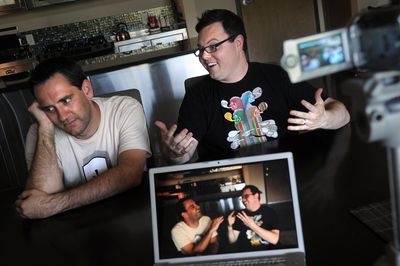Podcast this!
With right equipment, you, too, can find a home on the Web

Spokane’s podcasting duo of Remi Olsen and Stefan Shipman don’t try to do anything clever or brilliant with their weekly 30-minute episodes. The two friends turn on the camera, say what comes into their heads and laugh a lot.
They started in September 2007, and the relaxed podcast already has a sizable following. It’s called Remi and Stefan Do Spokane (found at SpokaneOwnsYou.com) and the two say it reaches audiences as far as the United Kingdom and Norway.
Neither is especially geeky or heavily into terms like RSS (Real Simple Syndication), XML, Internet feed, MP3 or WMA. They just enjoy letting loose and seeing if others have as much fun watching as they do recording. Olsen and Shipman illustrate one thing clearly: Nearly anyone can be a podcaster.
Millions of people are downloading and listening to podcasts — Web-delivered audio or video recordings, usually about a specific topic such as cooking, wine or movies. Podcasts are largely an untapped market that you can take advantage of with a modest investment and fairly basic technology skills. If you have a computer with access to the Internet, a microphone and a video camera, you can be podcasting in about 10 minutes.
Find a topic that interests you and try to create your first show. After you do a couple of podcasts, the process becomes easier.
After watching Remi and Stefan Do Spokane, I was inspired to have my debut in this largely untapped market. I did some research on how to produce a good quality podcast on a law student budget: $0.
To my surprise, I was able to create my first podcast in about 20 minutes. All I needed was fairly basic technology skills, an old Windows XP computer with access to the Internet, a microphone and a video camera.
After Googling free recording software and checking the consumer reviews to make sure it did not have viruses or bugs, I downloaded a program called Audacity from audacity.sourceforge.net. Audacity allows you to export or save your files as MP3 format. It also gives you great flexibility in recording different tracks, editing your work and adding music and mixing sounds into the final version.
I recorded my “show” and saved it as an MP3 file (the format for audio). My first ramblings as an Internet podcaster were finally created. Now it was time to distribute my creation to the world by uploading it to the Web.
There are hosting options for non-Web site owners. I checked Ourmedia.org, which is free and allowed me to create my own page and channels, and showcase my podcasts. Ourmedia pages behave similar to a MySpace page, but it allows you to upload your podcast. The only real drawback is that after uploading your file, you must wait up to 24 hours to access it. This can be a problem if the podcast is time sensitive.
Other services like AudioBlog.com or LiberatedSyndication.com charge a fee ($5 a month) for 100 megabytes of monthly storage. This can be a good solution if you would like to distribute the podcast as soon as it is created.
My podcast was not time sensitive, so Ourmedia did the trick. I also uploaded it to iTunes by accessing the iTunes desktop application, going to iTunes Store, then submitting the podcast. My recording was available for searches within a couple of hours.
If you would like to have your podcast on your own site, you can upload the podcast to your server and embed it on your page. However, you must create an XML file so you can distribute your content. If you are using WordPress, Blogger or LiveJournal, the XML file will be created automatically.
Do not let the terms XML or RSS bother you. Think of it this way: XML is the news and RSS is the paperboy. XML is the language a podcast uses to tell the world that you have created a new recording on the Web. RSS is the way that content is distributed.
If you are not using any of these services, then TDscripts will make the necessary XML file for you at no cost. Just visit that site (tdscritps.com), and type the information asked about your podcast and hit the create button. TDscripts creates the XML code that you copy and paste into Notepad. Next, change the file extension from .TXT to .XML. Then upload the newly created XML file to your server and link to it from your Web page. If you forget to create a link, the search engines will not find it and never know of your podcast.
The last step is to submit your podcast to the search engines. I use www.pingomatic.com to ping and submit my XML file to several of them at the same time. This activity alerts the computer search bots to “crawl” or index your Web page and locate the podcast there.